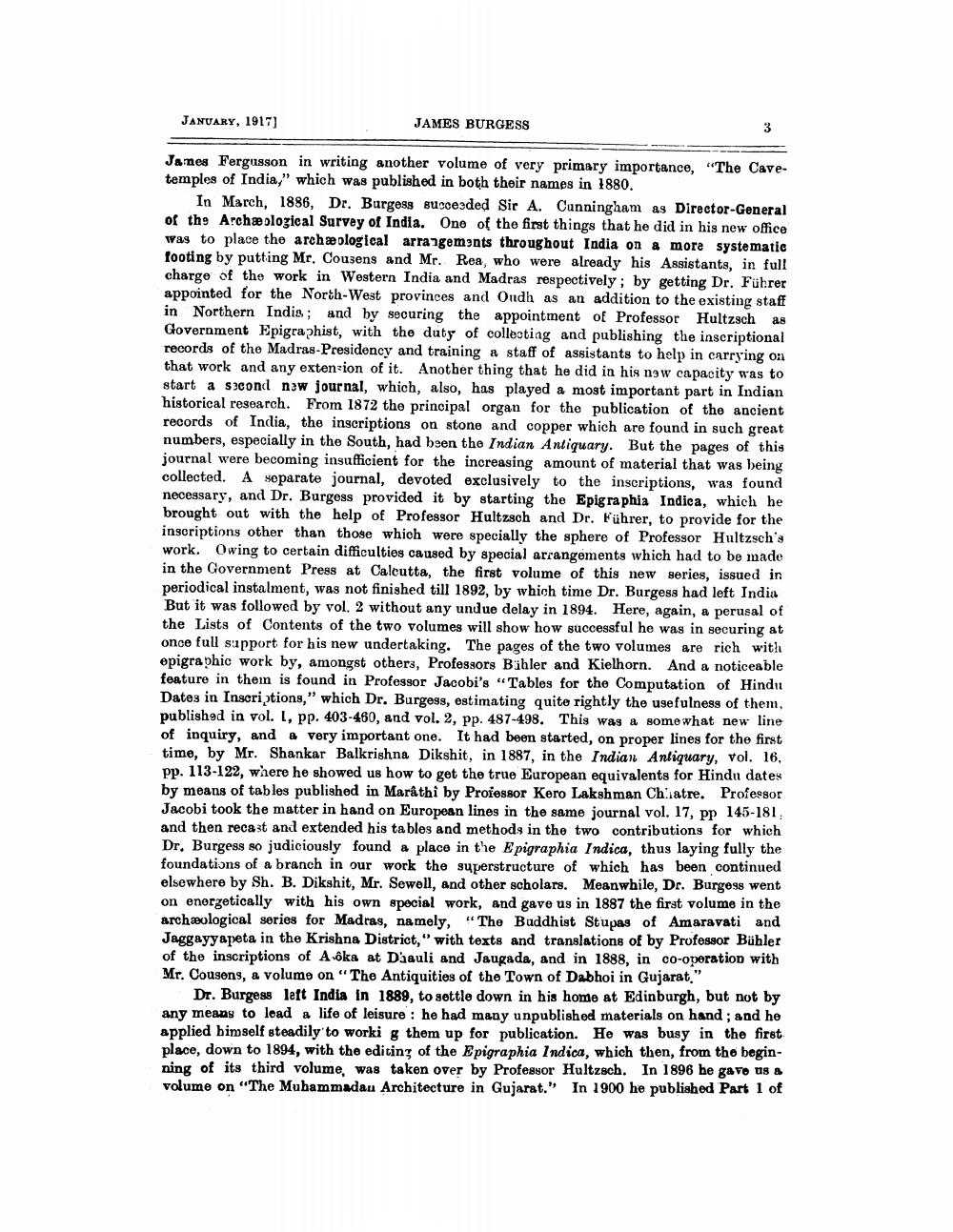Book Title: Indian Antiquary Vol 46 Author(s): Richard Carnac Temple, Devadatta Ramkrishna Bhandarkar Publisher: Swati Publications View full book textPage 7
________________ JANUARY, 1917) JAMES BURGESS Janes Fergusson in writing another volume of very primary importance, "The Cave temples of India," which was published in both their names in 1880. In March, 1886. Dr. Burgess Busseeded Sir A. Cunningham as Director-General of the Archæological Survey of India. One of the first things that he did in his new office was to place the archaeological arrangements throughout India on a more systematic footing by putting Mr. Cousens and Mr. Rea, who were already his Assistants, in full charge of the work in Western India and Madras respectively; by getting Dr. Führer appointed for the North-West provinces and Oudh as an addition to the existing staff in Northern India; and by securing the appointment of Professor Hultzsch as Government Epigraphist, with the duty of collecting and publishing the inscriptional records of the Madras-Presidency and training a staff of assistants to help in carrying on that work and any extension of it. Another thing that he did in his new capacity was to start a sicond now journal, which, also, has played a most important part in Indian historical research. From 1872 the principal organ for the publication of the ancient records of India, the inscriptions on stone and copper which are found in such great numbers, especially in the South, had been the Indian Antiquary. But the pages of this journal were becoming insufficient for the increasing amount of material that was being collected. A separate journal, devoted exclusively to the inscriptions, was found necessary, and Dr. Burgess provided it by starting the Epigraphia Indica, which he brought out with the help of Professor Hultzsch and Dr. Führer, to provide for the inscriptions other than those which were specially the sphere of Professor Hultzsch's work. Owing to certain difficulties caused by special arrangements which had to be made in the Government Press at Calcutta, the first volume of this new series, issued in periodical instalment, was not finished till 1892, by which time Dr. Burgess had left India But it was followed by vol. 2 without any undue delay in 1894. Here, again, a perusal of the Lists of Contents of the two volumes will show how successful he was in securing at once full support for his new undertaking. The pages of the two volumes are rich with epigraphic work by, amongst others, Professors Bihler and Kielhorn. And a noticeable feature in them is found in Professor Jacobi's "Tables for the Computation of Hindu Dates in Inscriptions," which Dr. Burgess, estimating quite rightly the usefulness of them, published in vol. I, pp. 403-460, and vol. 2, pp. 487-498. This was a somewhat new line of inquiry, and very important one. It had been started, on proper lines for the first time, by Mr. Shankar Balkrishna Dikshit, in 1887, in the Indian Antiquary, vol. 16, pp. 113-122, where he showed us how to get the true European equivalents for Hindu dates by means of tables published in Marathi by Proiessor Kero Lakshman Chilatre. Professor Jacobi took the matter in hand on European lines in the same journal vol. 17, pp 145-181, and then recast and extended his tables and methods in the two contributions for which Dr. Burgess so judiciously found a place in the Epigraphia Indica, thus laying fully the foundations of a branch in our work the superstructure of which has been continued elsewhere by Sh. B. Dikshit, Mr. Sewell, and other scholars. Meanwhile, Dr. Burgess went on energetically with his own special work, and gave us in 1887 the first volume in the archæological series for Madras, namely, "The Buddhist Stupas of Amaravati and Jaggayyapeta in the Krishna District," with texts and translations of by Professor Bühler of the inscriptions of Aoka at Diauli and Jaugada, and in 1888, in co-operation with Mr. Cousong, a volume on "The Antiquities of the Town of Dabhoi in Gujarat," Dr. Burgess left India in 1889, to settle down in his home at Edinburgh, but not by any means to lead a life of leisure : he had many unpublished materials on hand; and he applied himself steadily to worki g them up for publication. He was busy in the first place, down to 1894, with the editing of the Epigraphia Indica, which then, from the beginning of its third volume, was taken over by Professor Hultzsch. In 1896 he gave us & volume on "The Muhammadau Architecture in Gujarat." In 1900 he published Part 1 ofPage Navigation
1 ... 5 6 7 8 9 10 11 12 13 14 15 16 17 18 19 20 21 22 23 24 25 26 27 28 29 30 31 32 33 34 35 36 37 38 39 40 41 42 43 44 45 46 47 48 49 50 51 52 53 54 55 56 57 58 59 60 61 62 63 64 65 66 67 68 69 70 71 72 ... 508
